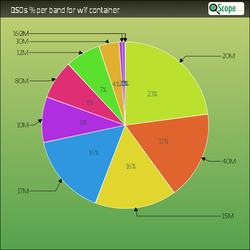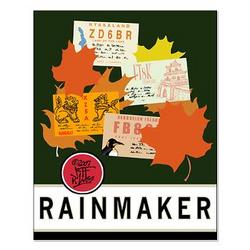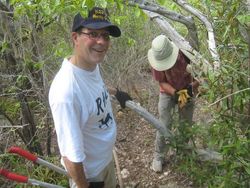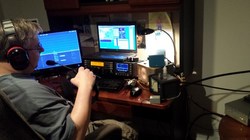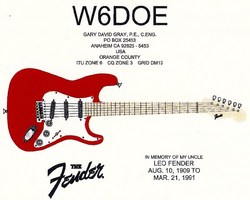 January 29, 2014 Editor: Ward Silver, NØAX | |||||||
IN THIS ISSUE
NEW HF OPERATORS - THINGS TO DO There are two great activities coming up - one outside and one inside. Outdoors, of course, is the Freeze Your Butt Off contest in which temperature at the operating position is part of the exchange! To warm up from that, come inside and tune for student teams operating in the weekday, Monday-to-Friday School Club Roundup. February is full of contesting fun! BULLETINS There are 30 contests using at least 7 modes over the next two weeks, one major DXpedition, and the W1AW operations will first move to Minnesota and Texas, then Georgia and Hawaii. Let us all brush up on our inter-personal skills and receiver operating abilities. BUSTED QSOS The inspectors found no violations in the Contest Update Café's previous issue. CONTEST SUMMARY Complete information for all contests follows the Conversation section February 1-2
February 8-9
Big changes around the ARRL Contest Branch Manager (CBM) as Mike DeChristopher, N1TA has resigned from the position. Picking up the reins temporarily are a quartet of familiar call signs led by Membership and Volunteer Programs Manager, Dave Patton, NN1N. Dave will be coordinating work by previous CBMs KX9X and N1ND, assisted (or at least entertained) by your editor, to produce the many writeups, results, and awards of the 19-contest program. In other ARRL Contest news:
The Daily DX reports that Brazil's ham organization, LABRE, is marking its 80 years from February 1 at 0300Z until February 3 at 0259Z. Stations all over the country will have special call signs starting with ZZ80. This may complicate some of this weekend's contests unless your prefix-to-country lookup list (CTY file) is up to date! If you had problems uploading your log for the recent CW North American QSO Party (NAQP CW), please check the logs received page on the new National Contest Journal website to verify it was accepted. All logs emailed directly to Chris KL9A, the contest manager, should be listed. If you don't see your log listed, please resubmit via the webpage upload.
This New York Times article offers some interesting new thoughts about long term sleep deprivation. More accurately, what happens during sleep and how to recover from periods when you don't get enough sleep - such as during our favorite on the air activities. Managing the operator's need for sleep is a critical part of contesting success. (Thanks, Randy K5ZD) There have been rumors of another "Polar Vortex" hitting Minnesota during the state's QSO party this weekend, but Mark WAØMHJ has heard that mobile operations will go on, as long as the temperature stays above minus 35 F. Isn't that the temperature at which HF signals change to MF? There is an extensive review of the intriguing new Array Solutions Shared-Apex Loop Array (SAL-30) by Brian N3OC in the February issue of the Potomac Valley Radio Club newsletter. Rules for both of the "North American" contests sponsored by the National Contest Journal - the NAQP QSO Party and the NA Sprint are lots easier to find on the new NCJ website. In addition, you can click on a link in the rules PDF and be taken directly to the appropriate web form, making that document the "final authority" complete with live links. You can still follow the menu links on the NCJ web site of course. (Thanks, NCJ Editor, Kirk K4RO) You know what would be good would be a compass-like smartphone app that would automatically determine your current location and show you the bearing to any other six-character grid locator. I'd call it TharTiz. Valery RG5A has been working from the CQ World Wide public log database and has developed a set of top rates achieved by the various stations. This interesting history behind the development and adoption of the analog NTSC color television signal standard turned up on the TV Technology website. Has it really been 60 years of living color? For those readers who decry today's endless legal battles over technology rights, you may be somewhat comforted to know that the situation is "the same as it ever was." (Thanks, Eric W3DQ) Bob WA1Z reports that he will "be releasing a new version of the Super Check Partial database files on Wednesday, February 5. I am requesting your logs for input to the database files. If there is a new contesting call sign you want added to the database for activity in the next few months, let me know before the February update." Bob's next update of the SCP file will be in early May. You can send him Cabrillo-formatted logs by email. If keeping track of all the bands and modes is keeping you up nights during the ARRL Centennial QSO Party, Anthony K8ZT has created a Google Docs spreadsheet for tracking contacts with all of those W1AW-portable stations. It is a beta-test version so he would appreciate any feedback or error reports you might find. In the ANS-026 issue of the AMSAT News Bulletins, John K8YSE gives a tip of the cap "to Mark Spencer, WA8SME at the ARRL for his excellent paper describing Funcube, its experiments and how to receive it and make sense of the data." Since there is a lot of interest in antennas to work or receive the signals from the satellites, "Mark seeks to quantify the performance of some common antennas like the M2 circularly-polarized beam, Arrow (antennas) fixed or on rotators, with or without preamps, and the 5/8-wave and ¼-wave ground planes. He does that by comparing the number of packets received on each antenna during a pass. The results are quite interesting." Jose CT1BOH reports that, "Anacom which regulates and supervises the electronic and postal communications sector in Portugal has authorized the use of 1850-2000 kHz for several international contests in 2014, with the same conditions that exist for the 1830-1850 segment." Contests allowed include the CQ WW and CQ WW 160, ARRL DX, CQ WPX, S.M El Rey de España, the IARU HF Championship, and ARRL 160 Meter contests. Note that digital operation is not listed.
Aggregator 3.0 is now available for download on the Reverse Beacon Net (RBN) web site. It adds the ability to selectively combine up to eight Telnet streams from various combinations of CW and DL4RCK RTTY/PSK skimmers without having to use WintelnetX or a cluster server to perform the actual merger. (Thanks, Pete N4ZR) As the newsletter is being assembled, January 28th, it would be the 128th birthday of Hidetsugu Yagi, co-inventor of the Yagi-Uda beam antenna much in evidence throughout ham radio-dom. Happy birthday to Dr. Yagi! And thanks to co-inventor, Dr. Uda, too. (Thanks, Kate K6HTN) Web Site of the Week - Andy K1RA spent the last week pulling together a log, media files such as photos and a slide show, and some software tools to write a lengthy article covering preparation and the ARRL January VHF Contest weekend experience as the K1RA-K8GP Rover. He says, "It seems I spent more time doing this than operating, but I really enjoy the Radiosport and hope to share some of the experience and excitement with newcomers and old timers alike. I'm celebrating 35 yrs on V/UHF this year after making my first VHF SSB/CW contest QSOs back in 1979 as a young WB1ALW and KA1GD." He's also published information on his log visualization tool and encourages your feedback. WORD TO THE WISE "A multiplier isn't much of one until you have something to multiply it by," opines Dan K1TO. His point? You need QSOs in the log, multipliers or not. Pay attention to the "QSOs per multiplier" number your logging software might provide. If you give up more QSOs than that number to chase a multiplier - no matter how juicy - then your score suffers. Here's a nine-part mini-series of videos about firing up one of the Marconi BD272 250 kW short-wave transmitters used for the BBC's World Service at Woofferton. It uses HUGE tubes. The camera gets right inside and the Chief Engineer walksyou through the components and signal path; very interesting. (Thanks, Kirk K4RO)
Geoff WØCG/PJ2T has published an online album of photos from the 2013 CQ World Wide CW contest. There is a lot of work involved in putting on such a big operation! What eating utensil should you use to get stations into your log? How about a fork, suggests Jim K2MIJ? "Yes that's right a fork! Well, two of them to be precise...sitting down at breakfast this morning staring at the fork in my hand I wondered if it would be possible to radiate a signal on a "Fork Dipole"....of course I had to try it...would my amazing LDG Z11 autotuner be able to find a match and actually load this tiny tenna? Fired up the FT-817 @ 5 watts and tuning 12 meters I heard W1AW/5 (K5CM) calling and working a pile...I shouted and shouted a good 15 times and you could have knocked me over with a SPOON when he came back and asked "K2MIJ, do I have the call correct?" WooHoo!" You can check out the setup in Jim's YouTube video! Perhaps it was knife-edge propagation? The popular "Factors of 10" animation has been updated in a new "Scale of the Universe" animation by Cary Huang which is hosted on the NASA Astronomy Picture of the Day web site. Have fun trying to grasp the sheer range of it all! The IARU HF Championship extended results article by Nate N4YDU has been published on the ARRL Contest Branch website. Sean KX9X has made a comprehensive update of the Contest Branch's plaques and certificates processing status page, as well. The CQ WW team is looking for pictures or videos of your experience in the 2013 CQ WW SSB and CW contests. Please send them directly to CQ WW Director Randy K5ZD. Pictures can be sent as attachments while he requests that you send links to videos. OPERATING TIP As noted at the beginning of this issue, February is packed with contests, DXpeditions, special stations, and so forth. Keep your cool on the air when some other activity collides with your contest or vice versa. After mentioning the iPhone RF calculator app last time, Chip N3IW contributed news of the Elektor RF & Microwave Toolbox from Android-Design.nl. "It is really full-featured. I've used it a good bit in my day-day work as an electrical engineer. It does OK on a phone, but a tablet would be recommended for some of the more detailed calculations that use graphs. The free version includes eight tools like VSWR and mismatch calculators and Pi/T attenuators. For $9.99, you get a total of 55 tools that has the 8 free tools plus tools like a PCB trace calculator, image rejection, mixer harmonics, many converters, and filter design." Those SMD components sure are small - here's an Instructables how-to that shows simple steps to snag some SMD soldering savvy. Don't let your amp "tee" you off - try Ian GM3SEK's designs that combine dc with RF up to 1 kW of power all the way to 6 meters! Tom W8JI notes that using bias tees with sensitive RF instrumentation such as the MFJ-259 series of analyzers can lead to damage of the detector diodes. "You can damage the 259 unless you use a smaller series cap and a shunt choke to protect the 259. The most important point I am trying to make is to never connect a bias tee without a shunt choke, especially one with a large series coupling cap, to the 259 input port. The 259 uses 10-volt microwave diodes, and the charging current of the cap can cause that much or more voltage to appear across the diodes." Tom also cautions us to watch out for relays on the line since the transient caused by turning a relay coil off can also damage the diodes.
Here's an interesting design article in EDN magazine that discusses how to reduce and control EMI caused by high-speed digital interfaces. With signal components that run into the hundreds of MHz, this can be quite a problem! Seen in a recent issue of Wired magazine, littleBits - tiny electronic modules that snap together magnetically. You can add your own household "stuff" to create projects. Great fun for kids and others just learning about electronics. Wow - here's quite the antenna switch! It's a 2-radio/6-antenna design with high isolation from KK1L. David K1TTT also posted a link to his receive antenna switching unit. (Thanks, Larry W6NWS) Stew K3ND sends a link to pictures of his tilt-over mount for a 60-foot 80/160 vertical. It uses two aluminum plates joined by a heavy duty gate hinge. A small winch and gin pole tilt the vertical over for any maintenance or repairs by using the falling derrick method. Another hinged design for a 160-40 meter vertical comes from Dan K3ZX.
Peter DJ7WW posted a link and a recommendation to the SWR bridge descriptions and design information from Dominique F1FRV. If you want some design detail - this is the place! It's common to use an oscilloscope to view the relative timing of the relays in a QSK system. How can you sample the RF as simply as possible when absolute amplitude isn't important, but timing is? Paul W9AC responds that "For quick QSK timing measurements, I often inductively couple the sample point to the scope. You can use a short coaxial jumper with BNC connectors on both ends and connect one end to the scope, the other end to a BNC-to-banana adapter. Then, take an alligator clip test lead and wrap it in close proximity to the sample point. The lead ends are connected across the adapter. Unless you're sampling low power, there's often enough coaxial leakage to just wrap the lead around the coaxial jumper. Then, adjust the scope's vertical amplifier to fill the display. Generally, I can get good display quality without much noise. You may need to experiment with more or less turns around the line." Technical Web Site of the Week - Two pages on the Frets magazine website dealing with instrument repair and construction are definitely of interest to every home builder - radio hams, included! The first is a large collection of Shop Tips and the second is a long list of "how to's" with common shop tools. Great reading! And while you're in the mood, how about some new tools? Makezine runs an annual "Our Favorite New Tools" article that will certainly get your workshop juices flowing. Chewing Through the Straps As I've noted elsewhere in this issue, we have some very busy times coming up - not just this weekend (30 contests plus all the other goings-on) but for the rest of 2014 as the W1AW-portable stations continue to rack up big QSO totals all week, every week. The Nebraska total for W1AW/Ø was more than 23,000 - and there were still plenty of stations calling when the clock rolled over at 0000 UTC on Wednesday! As this material is written, the FT5ZM expedition is attracting huge pileups, as well. I'd say this calls some reflection and planning. While hams should strive to be flexible in their on-air habits, many act as if we are still operating with crystal control and S-38 receivers. While I understand the tradition of CW-goes-here and digital-goes-there and this is the calling frequency for those stations and this is the calling frequency for these stations, there is a point at which that approach to spectrum management breaks down. Like now, for instance. We have amazing transceivers with computer interfaces, spectrum displays that rival anything coming out of an instrumentation lab, automata listening and spotting every station that signs a call within a few seconds, and worldwide computer networks operating at mega-bit speeds. Yet we cannot seem to adjust our operating frequency without it becoming a total calamity.
You mean if the NCS has to call the net to order a few kHz away from the regular frequency, the operators won't be able to find it? Really? You mean if the DXpedition pileup starts crowding onto your run frequency, you can't find another one? Really? And with the shoe on the other foot, you mean that if the DXpedition starts calling on a different frequency than the one they published weeks ago, you won't be able to find them? Really? Apparently, yes, really. Gosh, what would happen during a wide-spread disaster in which we actually had to choose operating frequencies on the fly? There is a point at which tradition becomes a jailer! We have a tremendous amount of latitude in how we choose to operate and a fair amount of spectrum in which to do it. Where does it say that all CW operation just simply has to be in the low end of the band? And that digital has to be below 100 kHz from the band edge? These customs were established decades ago! Sure, the band plan says where conventional operating takes place but band plans are for normal band loading and they're not regulations. All it takes is a couple of posts on the Internet or spots on the international spotting networks and a new center of activity can be established, just like we do under those emergency conditions. Let's think ahead - have a Plan B (and C and D...) whether it is for our nets, our contests, our every-night ragchews, even our DXpeditions. And let's recalibrate our expectations in light of both knowing there will be crowding and of having all manner of calendars and websites to inform us about what's happening. There is no reason to be surprised. The amateur service is fortunate to have the most flexible operating rules of any civilian telecommunication service in the world, bar none. Frequency agility is one of our most precious characteristics. So maybe we should chew through our self-imposed straps every once in a while and make use of it! 29 January through 11 February An expanded, downloadable version of QST's Contest Corral in PDF format is available. Check the sponsor's Web site for information on operating time restrictions and other instructions. HF CONTESTS North American Sprint--CW, from Feb 2, 0000Z to Feb 2, 0359Z. Bands (MHz): 3.5-14. Exchange: Both call signs, serial, name, and S/P/C. Logs due: 7 days. Rules School Club Roundup--Phone,CW,Digital, from Feb 10, 1300Z to Feb 14, 2359Z. Bands (MHz): 1.8-28, 50+. Exchange: RS(T), Class, S/P/C. Logs due: 30 days. Rules Triathlon DX Contest--Phone,CW,Digital, from Feb 1, 0000Z to Feb 1, 2359Z. Bands (MHz): 3.5-28. Exchange: RS(T) and serial. Logs due: 28 Feb. Rules EPC WW PSK Contest--Digital, from Feb 1, 0000Z to Feb 2, 2400Z. Bands (MHz): 1.8-28. Exchange: RST and serial. Logs due: 30 days. Rules Vermont QSO Party--Phone,CW,Digital, from Feb 1, 0000Z to Feb 2, 2400Z. Bands (MHz): 1.8-28, 50,144. Exchange: RS(T) and VT county or S/P/C. Logs due: 30 days. Rules Ten-Ten Winter Phone QSO Party--Phone, from Feb 1, 0001Z to Feb 2, 2359Z. Bands (MHz): 28. Exchange: Call sign, name, QTH, 10-10 number. Logs due: 15 days. Rules Black Sea Cup International--Phone,CW, from Feb 1, 1200Z to Feb 2, 1159Z. Bands (MHz): 1.8-28. Exchange: RS(T) and HQ ID, member nr or ITU zone. Logs due: 30 days. Rules FYBO Winter QRP Field Day--Phone,CW, from Feb 1, 1400Z to Feb 1, 2400Z. Bands (MHz): 1.8-28. Exchange: RS(T), S/P/C, name, power, temp in deg F. Logs due: 30 days. Rules http://www.azscqrpions.com Minnesota QSO Party--Phone,CW,Digital, from Feb 1, 1400Z to Feb 1, 2359Z. Bands (MHz): 1.8-28. CW 1.850, 3.550, 7.050, 14.050, 21.050, 28.050; SSB 1.870, 3.850, 7.250, 14.270, 21.350, 28.450 MHz. Exchange: Name and MN county or S/P/C. Logs due: Mar 15. Rules Straight Key Party--CW, from Feb 1, 1600Z to Feb 1, 1900Z. Bands (MHz): 3.5. Exchange: RST, serial, category, name, age. Logs due: Feb 28. Rules British Columbia QSO Party--Phone,CW,Digital, from Feb 1, 1600Z to Feb 2, 0400Z. Bands (MHz): 1.8-28. CW 1.815, 3.535, 7.035, 14.035, 21.035, 28.305; SSB 1.845, 3.85, 7.23, 14.25, 21.3, 28.4 MHz; Digital per band plan. Exchange: RST and BC district or S/P/Territory or DX. Logs due: Mar 31. Rules Delaware QSO Party--Phone,CW,Digital, from Feb 1, 1700Z to Feb 2, 2359Z. Bands (MHz): 1.8-28, 50+, CW 1.825, 3.55, 7.05, 14.05, 21.05, 28.05, 50.95; SSB 1.86, 3.96, 7.26, 14.26, 21.36, 28.36, 50.135 MHz; Digital per band plan. Exchange: RS(T) and DE county or S/P/C. Logs due: 30 days. Rules XE Int'l RTTY Contest--Digital, from Feb 1, 1800Z to Feb 2, 1759Z. Bands (MHz): 3.5-28. Exchange: RST and XE state or serial. Logs due: 30 days. Rules OK1WC Memorial Contest--Phone,CW, from Feb 3, 1600Z - See website. Multiple time periods. Bands (MHz): 3.5, 7. See website for bands. Exchange: RS(T) and serial. Logs due: 5 days. Rules ARS Spartan Sprint--CW, from Feb 4, 0200Z to Feb 4, 0400Z. Bands (MHz): 3.5-28. Monthly on the first Monday evening local time. Exchange: RST, S/P/C, and power. Logs due: 2 days. Rules NS Weekly Sprint--CW, from Feb 7, 0230Z to Feb 7, 0300Z. Bands (MHz): 1.8-14. Weekly on Thursday evenings local time. Exchange: Serial, name, and S/P/C. Logs due: 2 days. Rules YL-OM Contest--Phone,CW,Digital, from Feb 7, 1400Z to Feb 9, 0200Z. Bands (MHz): 1.8-28. Exchange: Call sign, RST, serial and S/P/C. Logs due: 30 days. Rules YLISSB QSO Party--CW, from Feb 8, 0000Z to Feb 9, 2359Z. Bands (MHz): 1.8-28. Exchange: Call sign, RS(T), ISSB number. Logs due: Mar 21. Rules CQ WW RTTY WPX--Digital, from Feb 8, 0000Z to Feb 9, 2400Z. Bands (MHz): 3.5-28. Exchange: RST and serial. Logs due: Feb 14. Rules Asia-Pacific Sprint--CW, from Feb 8, 1100Z to Feb 8, 1300Z. Bands (MHz): 7,14. Exchange: RST and serial. Logs due: 7 days. Rules Dutch PACC Contest--Phone,CW, from Feb 8, 1200Z to Feb 9, 1200Z. Bands (MHz): 1.8-28. Exchange: RS(T) and Dutch province or serial. Logs due: Mar 9. Rules Straight Key Weekend Sprintathon--CW, from Feb 8, 1200Z to Feb 9, 2359Z. Bands (MHz): 1.8-28, 50. Exchange: RST, QTH, name, member nr if member. Logs due: 5 days. Rules OMISS QSO Party--Phone, from Feb 8, 1500Z to Feb 9, 1500Z. Bands (MHz): 3.5-28. Exchange: RS, S/P/C and OMISS nr or "DX". Logs due: Mar 30. Rules New Hampshire QSO Party--Phone,CW,Digital, from Feb 8, 1600Z to Feb 9, 0400Z. Bands (MHz): 1.8-28. CW - 1.815 and band edge + 45kHz; Phone - 1.875, 3.935, 3.950, 7.235, 14.280, 21.380, 28.390 MHz. Exchange: RS(T) and NH county or S/P or "DX". Logs due: Mar 31. Rules FISTS CW Winter Sprint--CW, from Feb 8, 1700Z to Feb 8, 2100Z. Bands (MHz): 3.5-28. Exchange: RST, S/P/C, first name, FISTS nr or power. Logs due: 30 days. Rules RSGB - First 1.8 MHz Contest--Phone,CW, from Feb 8, 2100Z to Feb 9, 0100Z. Bands (MHz): 1.8. Exchange: RST, serial, UK district. Logs due: 16 days. Rules AM QSO Party--Phone, from Feb 8, 2300Z to Feb 9, 2300Z. Bands (MHz): 1.8-14. Exchange: RS, name, and S/P/C. Logs due: 4 weeks. Rules Classic Exchange--Phone, from Feb 9, 1400Z to Feb 10, 0800Z. Bands (MHz): 1.8-28, 50,144, AM--1.890, 3.880, 7.160, 7.290,1 4.286, 21.420, 29.000, 50.400, 144.300; SSB--1.885, 3.870, 7.280, 14.270, 21.370, 28.390, 50.125, 144.200 MHz. Exchange: RST, QTH, model of rcvr and xmtr. Logs due: 30 days. Rules Milwaukee FM Simplex Contest--Phone, from Feb 9, 1900Z to Feb 9, 2130Z. Bands (MHz): 50-440. Exchange: Call sign and grid square. Logs due: Mar 10. Rules VHF+ CONTESTS School Club Roundup--Phone,CW,Digital, from Feb 10, 1300Z to Feb 14, 2359Z. Bands (MHz): 1.8-28, 50+. Exchange: RS(T), Class, S/P/C. Logs due: 30 days. Rules Vermont QSO Party--Phone,CW,Digital, from Feb 1, 0000Z to Feb 2, 2400Z. Bands (MHz): 1.8-28, 50,144. Exchange: RS(T) and VT county or S/P/C. Logs due: 30 days. Rules Delaware QSO Party--Phone,CW,Digital, from Feb 1, 1700Z to Feb 2, 2359Z. Bands (MHz): 1.8-28, 50+, CW 1.825, 3.55, 7.05, 14.05, 21.05, 28.05, 50.95; SSB 1.86, 3.96, 7.26, 14.26, 21.36, 28.36, 50.135 MHz; Digital per band plan. Exchange: RS(T) and DE county or S/P/C. Logs due: 30 days. Rules Worldwide EME Contest--Phone,CW, from Feb 8, 0000Z to Feb 9, 2400Z. Bands (MHz): 144, 432. Exchange: TMO/RS(T) and "R". Logs due: Jun 15. Rules Straight Key Weekend Sprintathon--CW, from Feb 8, 1200Z to Feb 9, 2359Z. Bands (MHz): 1.8-28, 50. Exchange: RST, QTH, name, member nr if member. Logs due: 5 days. Rules Classic Exchange--Phone, from Feb 9, 1400Z to Feb 10, 0800Z. Bands (MHz): 1.8-28, 50,144, AM--1.890, 3.880, 7.160, 7.290,1 4.286, 21.420, 29.000, 50.400, 144.300; SSB--1.885, 3.870, 7.280, 14.270, 21.370, 28.390, 50.125, 144.200 MHz. Exchange: RST, QTH, model of rcvr and xmtr. Logs due: 30 days. Rules Milwaukee FM Simplex Contest--Phone, from Feb 9, 1900Z to Feb 9, 2130Z. Bands (MHz): 50-440. Exchange: Call sign and grid square. Logs due: Mar 10. Rules LOG DUE DATES 29 January through 11 February
ARRL Information Click here to advertise in this newsletter, space subject to availability. Your One-Stop Resource for Amateur Radio News and Information ARRL membership includes QST, Amateur Radio's most popular and informative journal, delivered to your mailbox each month. Subscribe to NCJ - the National Contest Journal. Published bimonthly, features articles by top contesters, letters, hints, statistics, scores, NA Sprint and QSO Parties. Subscribe to QEX - A Forum for Communications Experimenters. Published bimonthly, features technical articles, construction projects, columns and other items of interest to radio amateurs and communications professionals. Free of charge to ARRL members: Subscribe to The ARRL Letter (weekly digest of news and information), the ARES E-Letter (monthly public service and emergency communications news), Division and Section news -- and much more! ARRL offers a wide array of products to enhance your enjoyment of Amateur Radio. Visit the site often for new publications, specials and sales. Donate to the fund of your choice -- support programs not funded by member dues! Reprint permission can be obtained by sending email to permission@arrl.org with a description of the material and the reprint publication. ACKNOWLEDGEMENTS ARRL Contest Update wishes to acknowledge information from WA7BNM's Contest Calendar and SM3CER's Contest Calendar. | |||||||
